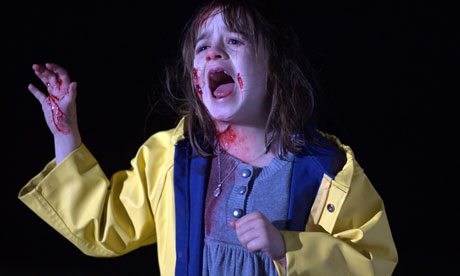
The awful significance of the title's first word dawns gradually. This macabre, black-comic horror, set in rural Ireland, is in the tradition of Don't Look Now, The Wicker Man and the communal nightmares of Ira Levin; it's a low-budget film that entertainingly takes its audience to the brink of pure absurdity. But it also riffs nastily and effectively on ideas of taboo, on our perennial yearning for ceremony and ritual to alleviate the sadness of life, and on Larkin's idea that what's truly scary is not dying but being dead.
In the time-honoured tradition of this kind of movie, a youngish, handsome professional couple are coping with the tragic loss of an only child. Aidan Gillen and Eva Birthistle are Patrick and Louise Daly, respectively a vet and a pharmacist, whose young daughter has died in horrendous circumstances. It's a painful memory shown to the audience in traumatised fragments. Patrick appears to run his practice in a town, and lives in what looks like a stylish Georgian terrace.
Roughly a year later, we see that this terrible event has caused them to sell up and move to the little rural village of Wake Wood (the film was shot in Pettigo, County Donegal) and while Louise works behind the counter of the local chemist's shop, Patrick instantly wins hearts and minds with his professional excellence – he is friendly, likable, willing to do difficult work. In an early scene, director and co-writer David Keating shows us, in graphic detail, Patrick expertly carrying out a caesarian section on a cow. In gore and danger, and the kind of eerie, unacknowledged violence that flavours the entire film, a calf is born; Patrick is congratulated by the local grandee, Arthur, played by Timothy Spall. He is cheerful, condescending and sinister in equal parts, and worryingly deferred to by all the villagers.
All Creatures Great and Small it ain't. Patrick and Louise are doing their best to make a new life for themselves, but are clearly clenched and unhappy, and Keating suggests that Louise's sixth sense for hidden misery causes her to be very interested in a middle-aged woman who comes into her shop one day with a weirdly pale, staring girl. This girl evidently has not been in the village for a while, and wonderingly comments that this pharmacy has been redecorated. Three days later, Louise is to see this same deathly-pale girl leaving the village, escorted out in the direction of neighbouring woodland by a grim ceremonial convoy of villagers playing little rattling drums, somewhere between a procession of the Blessed Virgin and an Orangemen's parade. Patrick and Louise are now told that if their own grief has become too much to bear, then the kindly village elders of Wake Wood have a proposal to make.
In addition to the creeping horror of the situation, and the sense of menace and threat that exists in nature generally ("Satan's theatre", as one of the characters in Lars von Trier's Antichrist calls it), Keating interestingly shows how Wake Wood has its own evil atmosphere generated by the huge wind turbines that dominate the landscape. So far from symbolising rational progress, the turbines are Stonehenge-like monuments of weirdness, incessantly turning and throbbing – an uncanny, oppressive heartbeat.
Wake Wood also makes the agony of birth a motif. That calving shown in the film's opening section is to have a queasy personal resonance as we are given hints that gynaecological complications following the difficult birth of Louise's lost child mean that having another baby would be a medical impossibility. Caesarian section becomes an unsettling, repeated theme, and Keating's Wake Wood almost conjures up memories of Birnam Wood in Shakespeare's Macbeth, and a killer who was from his mother's womb untimely ripped. Patrick's veterinarian skill in the art of the animal C-section is to resurface once more in the film's horrible final image.
Explicit moments of premeditated violence are in fact the less successful aspects of the film – the unending normal violence of country life, presented deadpan, is far more disturbing. At one stage, Patrick produces a stun gun for the disposal of a bull. The death blow is delivered off camera, and Keating shows how the sound makes all the stalled cattle withdraw their own heads in shock and fear: that is nothing to do with screen "horror", but it is authentically disturbing anyway, and is a part of the movie's satirical approach. Centuries of experience in animal husbandry, cultivating a placid acceptance of the cycle of birth and death, a fear of outsiders and submission to a malign nature have all mutated into this bizarre, secret phenomenon – a necrophiliac nightmare.

